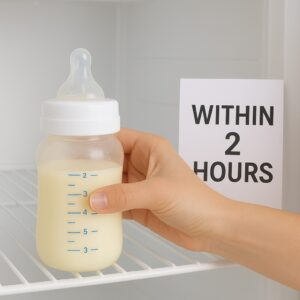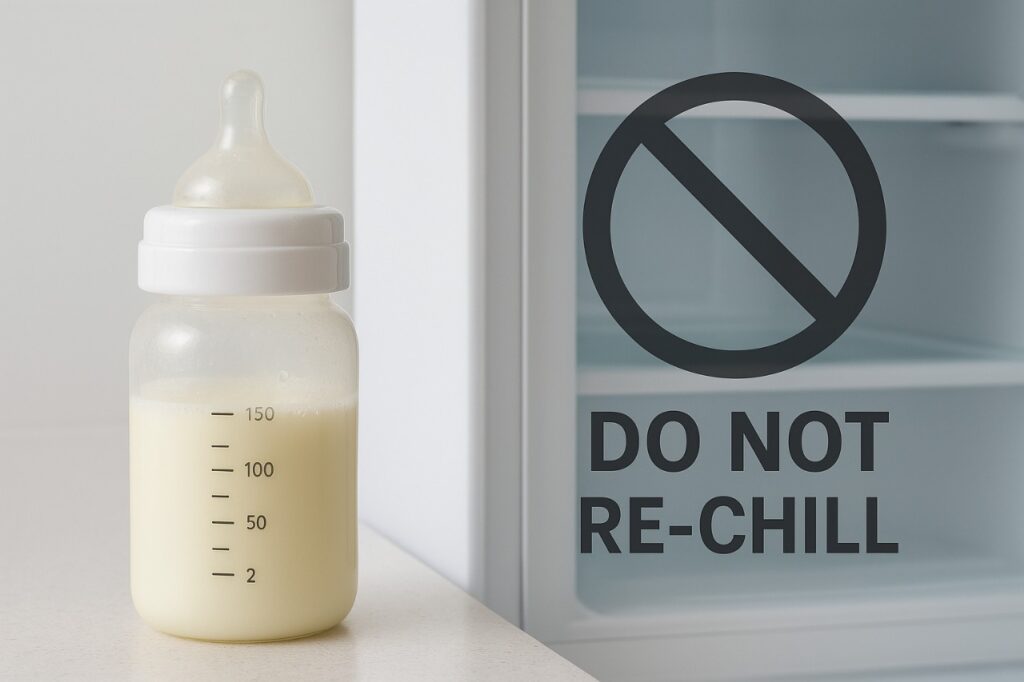Why Moms Often Wonder About This
You’ve just warmed a bottle of breast milk for your baby, but they didn’t finish it. Now you’re staring at the leftover milk and wondering — “Can I put it back in the fridge for later?”
It’s a question nearly every breastfeeding mom faces. Wasting breast milk feels painful because every ounce takes time and effort to pump. But safety comes first — and once milk has been warmed or partially used, its bacterial balance changes.
This guide explains when it’s safe to return breast milk to the fridge and when it’s best to discard it, following trusted sources like the CDC and Mayo Clinic.
👉 Before we dive in, read How Long Is Reheated Breast Milk Good For? (Storage Duration Guide) for detailed information on milk safety after warming.
Understanding the “Back in Fridge” Rule
The short answer: you should not put warmed or partially used breast milk back in the refrigerator.
Once milk has been warmed and your baby has started drinking from the bottle, bacteria from the baby’s mouth can mix with the milk. Even if you refrigerate it again, bacteria will continue to grow — refrigeration only slows, but doesn’t stop, bacterial activity.
According to the CDC’s breast milk handling guidelines, milk that has been touched by the baby’s saliva or left at room temperature for more than two hours should be discarded, not re-stored.
Why Re-Chilling Warmed Milk is Risky
Every time milk warms up, bacteria begin to multiply. If that milk cools down again, the bacteria don’t die — they remain active and continue to grow once it’s reheated or sits at room temperature again.
This cycle of warming and cooling can cause:
- Rapid bacterial growth.
- Loss of key immune proteins like lactoferrin and immunoglobulins.
- Increased risk of stomach infections for newborns.
Even though breast milk naturally contains antibodies, once exposed to air or baby’s mouth, its defenses weaken.
When It’s Still Safe to Refrigerate Again

There’s one small exception — if you warmed breast milk but never fed it to your baby, you may safely return it to the fridge within two hours of warming.
Here’s the rule of thumb:
- Unused but warmed milk: Can be put back in the fridge within 2 hours and used within 24 hours.
- Partially used milk (baby drank from it): Must be discarded after 2 hours, even if kept cool.
- Freshly pumped milk: Can be safely refrigerated for up to 4 days.
If you need help organizing or labeling milk, check our guide How to Store Breast Milk on the Go (Portable Storage Safety Guide).
Step-by-Step: Safe Milk Reuse Guidelines

- Use small portions: Instead of one large bottle, divide milk into 2–4 oz servings to minimize waste.
- Warm only what you need: Avoid heating the full batch unless you’re sure your baby will finish it.
- Check temperature: Never reheat milk more than once.
- Label dates and times: Always track when milk was first pumped and warmed.
- Follow the 2-hour rule: If milk sits out for more than 2 hours after warming, discard it.
These small habits can help you make the most of every ounce while keeping your baby safe.
Scientific Insight: Why Bacteria Multiply After Warming
When milk is expressed, it’s clean and filled with natural antibodies. But once exposed to warmth or saliva, bacteria such as Staphylococcus aureus and E. coli can multiply rapidly — even at refrigerator temperatures.
The fat and protein in milk create an ideal environment for bacterial growth. While refrigeration slows this process, it doesn’t stop it. That’s why the CDC and Mayo Clinic both recommend discarding any milk that’s been previously warmed or partially consumed.
FAQ: Common Questions About Reusing Milk
Q1: Can I reuse milk my baby didn’t finish?
No. Once your baby has drunk from the bottle, bacteria from their mouth enter the milk, making it unsafe for reuse.
Q2: What if the milk was warmed but not used?
If it was warmed but untouched, you can refrigerate it again within 2 hours and use within 24 hours.
Q3: Can I refreeze milk that was thawed and partially used?
Never refreeze previously thawed or warmed milk — it loses nutrients and may spoil faster.
Q4: How can I prevent waste if my baby drinks small amounts?
Store milk in smaller bottles (2–3 oz) so you only warm what’s needed.
Q5: What happens if I accidentally refrigerate used milk?
It may look fine, but invisible bacteria can still grow. It’s safest to discard and avoid the risk.
Conclusion: Safe Storage Starts with Smart Choices
You work hard to express every drop of milk — and it’s natural to want to save it. But once breast milk has been warmed or touched by your baby, it should not be put back in the refrigerator.
If you follow the 2-hour rule and prepare smaller portions, you’ll minimize waste while keeping your baby safe.
Always rely on trusted guidelines from the CDC and Mayo Clinic to build a healthy, safe feeding routine for your little one.



